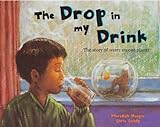Booklist:







Wednesday – introduce topic
Introduce this week’s topic (water – today’s focus will be on ecosystems) by reading Fish Is Fish
“How Animals Need Water to Survive”
Next, tell the children that you’ll be reading a story about an animal that lives in the water and you’ll be asking them to listen as you read so you can list the animals that HE ate and the animals that tried to eat HIM. As you read the story, let the children call out when they hear animals for the 2 lists and make the lists as you go along. Use another piece of chart paper. Read The Tale of Mr. Jeremy Fisher
“Animals that Frogs Eat”
“Animals that Eat Frogs”
Use your lists to make a food chain on a 3rd piece of chart paper, with the tiniest prey at the bottom and the biggest predators at the top. Then talk about how even the fiercest predator wouldn’t be able to survive without water. It is their habitat. Water seems like such a simple thing but we all depend on it!
Science Experiment:
Frogs are vulnerable to other threats besides being eaten. Water pollution is especially damaging to frogs. Do experiments 1 and 2 from “Frogs Tell Us Our Environment is Healthy”. Because salamanders, like frogs, are amphibians who also lay soft jelly-like eggs in water and have moist permeable skin, they are bio-indicators. Flag Ponds has a program where volunteers catch and count the number of salamanders each year. If the salamander population goes down, what might that indicate?
If there is extra time, have students do the Frog Pose (pp.18-19) and Fish Pose (pp.36-37) from Like a Fish in Water: Yoga for Children
Thursday – explore topic
Before students come in today, fill an ice cube tray with water combined with food coloring and stick it in the freezer for later.
Today’s focus will be on the fact that, since water is important for all life, that means us too! Begin by reading The Legend of the Bluebonnet
Science Experiment:
Do the activity from “Hold Water Upside Down!” (pp. 32-33 of Show Me How I Can Experiment (Show Me How I Can)
Read My Great Grandmother's Gourd
Science Experiment:
Talk about the water cycle (water on the ground evaporates up into the sky when warmed by the sun, as clouds grow heavier and heavier with water it begins to fall as rain, some rain soaks in the ground while some moves to rivers, ponds, etc. where it is then warmed by the sun and evaporates again). Use a piece of chart paper to diagram it. Then ask students if they have watched ice (solid form of water) melt (turning to liquid form) and evaporate as steam (turning to gas form). Most students should have already seen this before. Now ask them to try a science experiment with you. If you make ice cubes with color in them – which you did this morning – and put the ice cubes in a pan and turn on the heat under it, will the color go up into the air when the water turns to steam or will the color stay in the pan? Ask students to make a prediction, then go to the kitchen area to try it out!
Art Project:
Make Your Own Rain Stick
Friday – make field trip journals
While waiting for the field trip, read The Drop in My Drink: The Story of Water on Our Planet
Have each child write his/her name on the back of the artwork. Fold and hole punch 8 ½ x 11 white paper, punch artwork to match. Tie ribbons through holes. Have each child write the name of the field trip destination, the date, and his/her age on Page 1 of the journal. Have each child write a prediction of what he/she expects to see and do on the field trip on Page 2. Take the journals and a pencil for each child so that he/she can take notes on the field trip.
from The Waldorf Alphabet Book
Materials List
Ten pieces of large chart paper
Marker
Hard boiled chicken egg
Green jelly
Container of water
Piece of leather
Coffee filter
Coke
Ice cube tray
LARGE plastic bin
Large bowl of water
Food coloring
Plastic tumbler
Pencil
Scissors
Thick, smooth, shiny, flat cardstock
Ice cubes made with water and food coloring
Pot
Heat source
Cardboard tube (one for each child if possible, or the children can work in teams)
Box of 1-inch long nails
Marker
Masking or packing tape
Paper
Rice and/or small beans (uncooked)
Construction paper
Crayons
A glass of water
3 hole punch
8 ½ x 11 inch white paper
Ribbon in various colors
Pencils




 Immersive Experience
Immersive Experience Immersive Experience
Immersive Experience







No comments:
Post a Comment